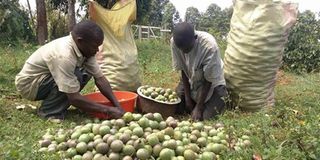Passion fruits, matooke bring in Shs7m a year for Kapchorwa farmer

A section of the farm on which Chemutai has planted Stevia, a crop that he is trying out. Right, top, he check on the support he uses for passion fruits. Right, below, workers sort a harvest of passion fruits. PHOTO BY ALLAN CHEKWECH
What you need to know:
He was trading in coffee for a considerable amount of time until he decided to grow it himself. Kalifani Chemutai told Allan Chekwech how what begun with coffee became a mix of passion fruits and matooke as well.
I am Kalifani Chemutai, a resident of Kapkway village, Tegeres Sub-county, Kapchorwa District, and it was in early 2012 that I started to plough the family land that had been lying idle for years and bought an extension to make it seven acres.
My main aim was to establish a coffee farm. This was because through my company, Masai Backpackers, I had been buying and selling coffee within Tegeres. But one day, I thought to myself that I should make use of the family land in Kapkway to grow my own coffee.
Getting started
This is when I decided to consult a farmer who also grows coffee to seek more knowledge. He advised me to intercrop it with matooke so that the coffee would get enough shade while growing.
So, I planted about 500 suckers of matooke, which would shield the 6,000 coffee seedlings from direct sunlight.
But then I realised that there was still space on the land, so I added 4,000 seedlings of passion fruits. The initial cost was high although I cannot state a particular figure. However, what I remember is that it was expensive.
So, between July and August 2012, I planted passion fruits alongside the matooke and coffee. I then hired a farm attendant to help out with various tasks on the farm. Being mid-year, there was enough rain for the crops to grow well.
By August 2013, a year after I planted the passion fruits, I got the first harvest. At first, it was about a bag, but between September and October that year, the harvest had increased to about five bags per week.
When I realised that I could harvest much more of the fruits, I went to Kampala to look for market for my produce. I talked to the management at Speke Hotels and they offered to buy some of my produce. We settled for Shs2,500 per kilogramme. A bag carries up to 70 killogrammes of passion fruit. So, I got Shs175,000 per bag.
Earnings
The business then started picking up. In November alone, I earned Shs3.5m from the fruits. This is in addition to Shs1.5m I earned in September and Shs2m in October. But because Speke Hotels cannot buy all the fruits, I also sell some on the local market in Kapchorwa.
For the matooke, I have so far sold 70 bunches at Shs10,000 each, which makes Shs700,000. As I wait for another harvest for matooke and passion fruits, the coffee has not yet matured but is growing steadily. However, there are a number of challenges that I face while carrying out this business.
Challenges
Kapkway is located in a remote place and transporting the produce during the rainy season is very difficult. I use donkeys whenever it rains, but the animals are not fast enough.
Being close to Mt Elgon National Park, the farm is always host to various monkeys. The monkeys eat passion fruits, ripe matooke and, at worst, destroy even the immature fruits.
I appeal to the Uganda Wildlife Authorities to intervene in this matter. I own a tours and travel company and I know what the animals mean to tourists. But they need to be protected so that they do not stray into people’s gardens.
costs and competition
Besides the above, Chemutai’s farm manager Patrick Soyekwo says passion fruits are prone to pests and diseases.
And because of this and other factors, they use about Shs400,000 to maintain the farm per month. This includes the labour in tending to the crops and weeding.
Chemutai also says because western Kenya produces many passion fruits and are relatively cheaper, they have flooded the Ugandan market, which hampers chances of earning more from the crop.
Other crops that are undergoing trial on Chemutai’s farm
Stevia plant
Chemutai has also tried out the stevia plant with success. He brought the plant from western Kenya to try it out in Uganda and he was not disappointed. The stevia plant has shown that it can grow in the cold Mt Elgon area as well. The leaves of this plant have 30 to 45 times the sweetness of ordinary sugar. Its leaves can be eaten fresh or put in tea and food.
In many parts of the world, the plant has been considered a healthy feed and alternative for diabetic people who like sugar. The plant has a long history of medicinal use by the Asians, having been used extensively by them for more than 1,500 years.
So with the reality that it can grow here as well, farmers could get an opportunity to help the diabetic people.
Strawberries
Chemutai did not know that strawberries would grow in Kapchorwa and he tried out a few plants. The result was positive as they yielded better than he had thought. He now considers acquiring more land to roll out the crop. Strawberries are said to be tough and will survive many conditions, but during fruit formation, moisture is vital, especially if growing in containers.
However, protection must be provided against slugs and snails, which attack the ripe fruit. The fruit matures mostly in July or August and should be picked when fully ripe — that is when the fruit is a uniform bright red colour.
Strawberries and strawberry flavourings are a popular addition to dairy products, such as milk ice cream, milkshakes, yogurt and smoothies.




